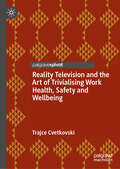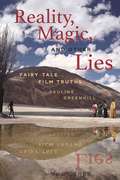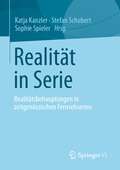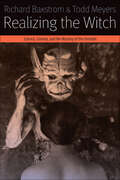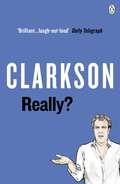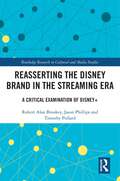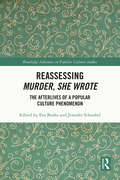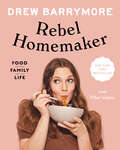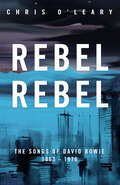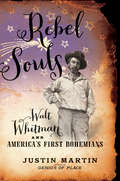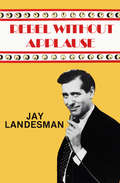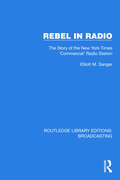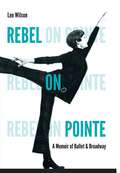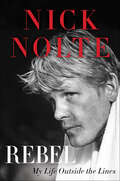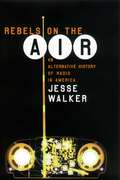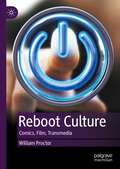- Table View
- List View
Reality Television and the Art of Trivialising Work Health, Safety and Wellbeing
by Trajce CvetkovskiThis book aims to assess the extent to which work health, safety and wellbeing (HSW) considerations are trivialised on the popular Australian reality TV programme, The Block. Reality TV as a genre plays a core feature in media and cultural studies, but there has not been any research on the impact of reality TV on safety culture, or how HSW issues are portrayed in popular media. This research remedies this deficiency and demonstrates contestants are workers on The Block who perform workplace activities. The work-related activities are concerned with construction, building and renovation work; and specifically, participants engage in what are seemingly routine or ordinary everyday life activities; namely housing construction and domestic or home dwelling renovations. It supports the argument claim that contestants on reality TV are defined as workers, and this definition of worker can be extended to other genres. The book ultimately demonstrates that reality television is trivialising HSW for the purposes of satisfying audience desire to consume popular culture, and these activities perpetuate a poor image of best safety practice.
Reality and Fantasy in American Independent Cinema: A Cavellian Approach
by Rick ZinmanIn the 21st century, blockbuster fantasy films have dominated film viewership in the United States. The increased popularity of fantasy films has generated much greater scholarly interest in the study of fantasy films. It has also generated an artistic response by American Indie filmmakers who have developed alternative approaches to the portrayal of film fantasy. Reality and Fantasy in American Indie Films: A Cavellian Approach applies the methods and procedures of Cavellian philosophical film criticism to the study of four prominent American indie films released in 2014 in which fantasy can be said to play an important role: Birdman (Alejandro G. Iñárritu); Boyhood (Richard Linklater); The Grand Budapest Hotel (Wes Anderson); and Only Lovers Left Alive (Jim Jarmusch).
Reality, Magic, and Other Lies: Fairy-Tale Film Truths (Series in Fairy-Tale Studies)
by Pauline GreenhillReality, Magic, and Other Lies: Fairy-Tale Film Truths explores connections and discontinuities between lies and truths in fairy-tale films to directly address the current politics of fairy tale and reality. Since the Enlightenment, notions of magic and wonder have been relegated to the realm of the fanciful, with science and reality understood as objective and true. But the skepticism associated with postmodern thought and critiques from diverse perspectives—including but not limited to anti-racist, decolonial, disability, and feminist theorizing—renders this binary distinction questionable. Further, the precise content of magic and science has shifted through history and across location. Pauline Greenhill offers the idea that fairy tales, particularly through the medium of film, often address those distinctions by making magic real and reality magical. Reality, Magic, and Other Lies consists of an introduction, two sections, and a conclusion, with the first section, "Studio, Director, and Writer Oeuvres," addressing how fairy-tale films engage with and challenge scientific or factual approaches to truth and reality, drawing on films from the stop-motion animation company LAIKA, the independent filmmaker Tarsem, and the storyteller and writer Fred Pellerin. The second section, "Themes and Issues from Three Fairy Tales," shows fairy-tale film magic exploring real-life issues and experiences using the stories of "Hansel and Gretel," "The Juniper Tree," and "Cinderella." The concluding section, "Moving Forward?" suggests that the key to facing the reality of contemporary issues is to invest in fairy tales as a guide, rather than a means of escape, by gathering your community and never forgetting to believe. Reality, Magic, and Other Lies—which will be of interest to film and fairy-tale scholars and students—considers the ways in which fairy tales in their mediated forms deconstruct the world and offer alternative views for peaceful, appropriate, just, and intersectionally multifaceted encounters with humans, non-human animals, and the rest of the environment.
Realität in Serie: Realitätsbehauptungen in zeitgenössischen Fernsehserien
by Katja Kanzler Sophie Spieler Stefan SchubertRealität(streue) ist ein markantes Thema in der Medienkultur des 21. Jahrhunderts, das sich auf widersprüchliche Weise entfaltet: Realness scheint derzeit sowohl eine Krise als auch eine Konjunktur zu erleben. Der vorliegende Band beleuchtet dieses Thema im medialen Kontext der Fernsehserie mit Hilfe von Fallstudien aus interdisziplinären Perspektiven. Im Mittelpunkt stehen dabei die sozialen, kulturellen, politischen und ästhetischen Potenziale von Realitätsbehauptungen und -effekten in seriellen Fernsehformaten.
Realizing the Witch: Science, Cinema, and the Mastery of the Invisible (Forms of Living)
by Richard Baxstrom Todd MeyersBenjamin Christensen’s Häxan (The Witch, 1922) stands as a singular film within the history of cinema. Deftly weaving contemporary scientific analysis and powerfully staged historical scenes of satanic initiation, confession under torture, possession, and persecution, Häxan creatively blends spectacle and argument to provoke a humanist re-evaluation of witchcraft in European history as well as the contemporary treatment of female “hysterics” and the mentally ill.In Realizing the Witch, Baxstrom and Meyers show how Häxan opens a window onto wider debates in the 1920s regarding the relationship of film to scientific evidence, the evolving study of religion from historical and anthropological perspectives, and the complex relations between popular culture, artistic expression, and concepts in medicine and psychology. Häxan is a film that travels along the winding path of art and science rather than between the narrow division of “documentary” and “fiction.” Baxstrom and Meyers reveal how Christensen’s attempt to tame the irrationality of “the witch” risked validating the very "nonsense" that such an effort sought to master and dispel. Häxan is a notorious, genre-bending, excessive cinematic account of the witch in early modern Europe. Realizing the Witch not only illustrates the underrated importance of the film within the canons of classic cinema, it lays bare the relation of the invisible to that which we cannot prove but nevertheless “know” to be there.
Really the Blues
by Bernard Wolfe Ben Ratliff Mezz MezzrowMezz Mezzrow was a Jewish boy from the slums of Chicago who learned to play the clarinet in reform school and pursued a life in music and a life of crime. He moved from Chicago to New Orleans to New York, working in brothels and bars, bootlegging, dealing drugs, getting hooked, doing time, producing records, and playing with the greats, among them Louis Armstrong, Bix Beiderbecke, and Fats Waller. Really the Blues, the jive-talking memoir that Mezzrow wrote at the insistence of, and with the help of, the novelist Bernard Wolfe, is the story of an unusual and unusually American life, and a picture of a man who moved freely across racial boundaries when few could or did, "the odyssey of an individualist. . . the saga of a guy who wanted to make friends in a jungle were everyone was too busy making money."
Really?: The World According To Clarkson
by Jeremy ClarksonJEREMY CLARKSON'S LATEST - AND MOST OUTRAGEOUS - TAKE ON THE WORLDCLARKSON'S BACK - AND THIS TIME HE'S PUTTING HIS FOOT DOWNFrom his first job as a travelling sales rep selling Paddington Bears to his latest wheeze as a gentleman farmer, Jeremy Clarkson's love of cars has just about kept him out of trouble.But in a persistently infuriating world, sometimes you have to race full-throttle at the speed-bumps.Because there's still plenty to get cross about, including:· Why nothing good ever came out of a meeting· Muesli's unmentionable side effects · Navigating London when every single road is being dug up at once· People who read online reviews of dishwashers· ****ing driverless carsBuckle up for a bumpy ride - you're holding the only book in history to require seatbelts . . .Praise for Jeremy Clarkson: Brilliant . . . Laugh-out-loud' Daily Telegraph'Outrageously funny . . . Will have you in stitches' Time Out 'Very funny . . . I cracked up laughing on the tube' Evening Standard
Rear Window: The Making of a Hitchcock Masterpiece in the Hollywood Golden Age
by Jennifer O'CallaghanThe definitive, in-depth look inside the making of Alfred Hitchcock&’s Rear Window—the all-time classic of voyeurism, paranoia, and murder that became one of Hollywood&’s greatest achievements and turned generations of viewers into &“a race of Peeping Toms.&” . . . Before the internet and social media offered voyeuristic glimpses into the lives of others, the acclaimed Master of Suspense, Alfred Hitchcock, exposed the dangers and delights of looking—and knowing—too much in his 1954 masterpiece Rear Window. Widely hailed as one of the greatest films ever made, it stars James Stewart and Grace Kelly at the top of their game but, in an unusual gamble, is shot entirely from within a Greenwich Village apartment . . . Using this limited point of view, Hitchcock forces his audience to participate in his protagonist&’s voyeuristic impulses and darkest obsessions—a bold move in the era of the Hollywood Blacklist and restrictive Hays Code. But the gamble paid off, and Rear Window became a timeless classic. This eye-opening book goes straight to the source of Rear Window&’s genius by mining the original papers of Hitchcock, Jimmy Stewart, and Thelma Ritter, revealing little-known facts behind the scenes: Why taking the role of Lisa Fremont was one of the toughest decisions Grace Kelly ever made; How Hitchcock intertwined suspense and romance with inspiration from Ingrid Bergman; How he used a topless scene to distract the censors from other scenes to which they may have objected; and how Hitchcock crafted the film&’s unforgettable villain, Lars Thorwald, by modeling him on a producer he loathed—the infamous David O. Selznick. Filled with eye-catching photographs, outrageous anecdotes, and delicious details, this exciting book pulls back the curtain on a classic thriller that&’s as relevant today as ever—and every bit as thrilling.
Reasserting the Disney Brand in the Streaming Era: A Critical Examination of Disney+ (Routledge Research in Cultural and Media Studies)
by Robert Alan Brookey Jason Phillips Timothy PollardReasserting the Disney Brand in the Streaming Era investigates the evolution of the Disney brand at a pivotal moment – the move from content creation to acquisition and streaming – and how the company reasserted its brand in a changing marketplace. Exploring how Disney’s acquisition of Pixar, Marvel, Lucasfilm and Fox positioned the company to launch the Disney+ streaming service, the chapters look at the history of those acquisitions, and the deployment of the content, brands, and intellectual property from those acquisitions, through an analysis of the original content that appeared on Disney+. Offering a focused investigation of how the content offered from these various media brands was adapted for Disney+ so that it reflects the Disney brand, the authors illustrate through close textual analysis how this content reflects elements of the "Classic Disney Style." The analysis positions these texts in relation to their industrial contexts, while also identifying important touchstone texts (both television and film) in Disney's catalog. This comprehensive and thoughtful analysis will interest upper-level students and scholars of media studies, political economy, Disney studies, media industries and new technology.
Reassessing Murder, She Wrote: The Afterlives of a Popular Culture Phenomenon (Routledge Advances in Popular Culture Studies)
by Eva Burke Jennifer SchnabelThis book provides a critical overview of the cultural impact of the Murder, She Wrote TV series and its paratextual elements, including board and video games, podcasts, fan conventions, collectible figures, and ghostwritten novels. It also explores the series’ position within the crime genre, particularly its engagement with earlier iterations of the ‘lady detective’.Bringing together a broad range of experts, the book includes contributions from both academics and crime fiction novelists to offer a wide-ranging view of this popular series and its afterlives.Suitable for scholars and students working on popular culture, crime fiction, TV studies or fan studies, this collection provides an interdisciplinary analysis of one of the most successful and enduring female-fronted detective series in history.
Reattachment Theory: Queer Cinema of Remarriage (a Camera Obscura book)
by Lee WallaceIn Reattachment Theory Lee Wallace argues that homosexuality—far from being the threat to “traditional” marriage that same-sex marriage opponents have asserted—is so integral to its reimagining that all marriage is gay marriage. Drawing on the history of marriage, Stanley Cavell's analysis of Hollywood comedies of remarriage, and readings of recent gay and lesbian films, Wallace shows that queer experiments in domesticity have reshaped the affective and erotic horizons of heterosexual marriage and its defining principles: fidelity, exclusivity, and endurance. Wallace analyzes a series of films—Dorothy Arzner's Craig's Wife (1936); Tom Ford's A Single Man (2009); Lisa Cholodenko's High Art (1998), Laurel Canyon (2002), and The Kids Are All Right (2010); and Andrew Haigh's Weekend (2011) and 45 Years (2015)—that, she contends, do not simply reflect social and legal changes; they fundamentally alter our sense of what sexual attachment involves as both a social and a romantic form.
Rebecca and the Movies (American Girls #4)
by Jacqueline Dembar Greene<P>Rebecca can hardly believe it when cousin Max invites her to visit his movie studio! Although her parents don't approve of actors or movies, Mama relents and says she may go. <P>At the studio, Rebecca meets the glamorous Lily, a real movie star. When the camera begins to roll, Rebecca knows she must sit quietly and watch. Suddenly, the director shouts "Cut!" -- and Rebecca finds herself facing an opportunity she never imagined in her wildest dreams. <P>Does she have the nerve for it? And what would her parents say if they knew? <P>Rebecca and the Movies is the fourth book in the Rebecca, American-Girls collection, six-book series. Each story in the series reveals more about Rebecca, a lively Jewish girl, who grows up in 1914 in New York. The books in the Rebecca series include: Meet Rebecca, Rebecca and Ana, Candlelight for Rebecca, Rebecca and the Movies, Rebecca to the Rescue, and Changes for Rebecca. Every book of the series not only features a fictional, realistic story and has magnificent illustrations, the book also has a historical "Looking Back" section. In this "Looking Back" section, the author describes some of the historical characteristics of Rebecca's 1914 time period in a style which children can understand and adults can appreciate.
Rebel Dance, Renegade Stance: Timba Music and Black Identity in Cuba
by Umi VaughanRebel Dance, Renegade Stance shows how community music-makers and dancers take in all that is around them socially and globally, and publicly and bodily unfold their memories, sentiments, and raw responses within open spaces designated or commandeered for local popular dance. Umi Vaughan, an African American anthropologist, musician, dancer, and photographer "plantao" in Cuba—planted, living like a Cuban—reveals a rarely discussed perspective on contemporary Cuban society during the 1990s, the peak decade of timba, and beyond, as the Cuban leadership transferred from Fidel Castro to his brother. Simultaneously, the book reveals popular dance music in the context of a young and astutely educated Cuban generation of fierce and creative performers. By looking at the experiences of black Cubans and exploring the notion of "Afro Cuba," Rebel Dance, Renegade Stance explains timba's evolution and achieved significance in the larger context of Cuban culture. Vaughan discusses a maroon aesthetic extended beyond the colonial era to the context of contemporary society; describes the dance spaces of Cuba; and examines the performance of identity and desire through the character of the "especulador. " This book will find an audience with musicians, anthropologists, ethnomusicologists, interdisciplinary specialists in performance studies, cultural studies, and Latin American and Caribbean studies, as well as laypeople who are interested in Atlantic/African and African American/Africana studies and/or Cuban culture.
Rebel Homemaker: Food, Family, Life
by Drew Barrymore Pilar ValdesDrew Barrymore has always done things in her own unique way—including how she cooks, lives, and finds happiness at home. In her first lifestyle and cookbook, Drew shares recipes, stories from her life, and personal photos that show how she lives a healthy, delicious, and joyful life through her own rebellious brand of homemaking. In her first lifestyle book, Drew Barrymore will take you inside her kitchen and her life, sharing thirty-six amazing recipes, from Soft-Scrambled Yuzu Kosho Eggs to Brie and Apple Grilled Cheese to Harissa Spaghetti, which she developed along with chef Pilar Valdes, a personal friend and a regular guest on Drew&’s CBS talk show. The book will also feature beautiful photos, many taken by Drew herself, as well as personal essays and stories about how Drew found her way in the kitchen, learned to cook, planted a garden and raised her first chickens. And, of course, how she learned to slow down, turn to nature as a teacher, always remembering to be humble and present while celebrating the joys of her family and friends around the table, both during special occasions as well as amidst the beautiful chaos of everyday life!
Rebel Rebel: The Songs of David Bowie: 1963 - 1976
by Chris O'LearyDavid Bowie: every single song. Everything you want to know, everything you didn't know.The legacy of David Bowie is roughly 450 songs, which he recorded or performed over half a century. They range from cabaret to psychedelia to folk rock to glam rock to Philadelphia soul, from avant-garde instrumentals to stadium anthems. Cataloging Bowie&’s songs from the dawn of his career in 1963 to his Hollywood stardom in 1976, examining them in the order of their composition and recording, and digging into what makes them work, Rebel Rebel and its sequel Ashes to Ashes have become standard references for Bowie fans.The new edition of Rebel Rebel is a fully-updated revision, taking into account Bowie demos and alternate takes released in the years after his death. It&’s enhanced by a decade&’s worth of new information about Bowie&’s recording process, his influences, his contemporaries, and his live performances, all of which shed light onto the evolution of his songwriting. It shows how Bowie exploited studio innovations, and delves into the roles of his supporting musicians, particularly major collaborators like Mick Ronson and Tony Visconti.This book aligns Bowie&’s music with his times, planting his work in the context of its era. You&’ll see what Bowie&’s work owes to novelists like Keith Waterhouse, Jack Kerouac, George Orwell, Ray Bradbury, and William S. Burroughs. To films like Performance, 2001: A Space Odyssey, and A Clockwork Orange. To rival songwriters and performers like Marc Bolan, Bob Dylan, Bruce Springsteen, Lou Reed, Scott Walker, Elvis Presley, the Bee Gees, Isaac Hayes, James Brown, Pete Townshend, and John Lennon. With guest appearances by everyone from Frank Sinatra to Cher.
Rebel Rising: A Memoir of Singing, Sobbing, Laughing and Loving
by Rebel WilsonFrom the scene-stealing star of Pitch Perfect and Bridesmaids comes a &“lively and reflective celebrity memoir seasoned with comedy and sincerity&” (Kirkus Reviews) about Rebel Wilson&’s unconventional journey to Hollywood success and loving herself.This &“beautiful, brave book,&” (Jenna Bush Hager, Today) is the story of Rebel Wilson&’s remarkable personal transformation, from a painfully shy child in Australia who literally had to be dragged to drama classes to achieving breakout success in the US through iconic roles in Pitch Perfect, Bridesmaids, and Isn&’t It Romantic. Through &“stunningly personal revelations&” (The New York Times), Rebel shares the extraordinary experiences that shaped her life. A malaria-induced hallucination? An all-style martial arts fighting tournament? Junior handling at dog shows? And this was all BEFORE she moved to Hollywood! From her painful relationship with her father, weight gain and loss, a late-in-life sexual awakening, and fertility issues, Rebel shares her incredible journey to self-love in writing that is &“frank and fun&” (CBS Sunday Morning). Rebel leads you through her hard-fought path to &“making it,&” constantly questioning, &“Am I good enough? Will I ever find love? Will I ever change and become healthy?&” This extraordinarily entertaining memoir shows us how to love ourselves while making us laugh uncontrollably.
Rebel Souls: Walt Whitman and America's First Bohemians (A Merloyd Lawrence Book)
by Justin MartinIn the shadow of the Civil War, a circle of radicals in a rowdy saloon changed American society and helped set Walt Whitman on the path to poetic immortality.<P><P> Rebel Souls is the first book ever written about the colorful group of artists-- regulars at Pfaff's Saloon in Manhattan--rightly considered America's original Bohemians. Besides a young Whitman, the circle included actor Edwin Booth; trailblazing stand-up comic Artemus Ward; psychedelic drug pioneer and author Fitz Hugh Ludlow; and brazen performer Adah Menken, famous for her Naked Lady routine. Central to their times, the artists managed to forge connections with Ralph Waldo Emerson, Mark Twain, and even Abraham Lincoln. This vibrant tale, packed with original research, offers the pleasures of a great group biography like The Banquet Years or The Metaphysical Club. Justin Martin shows how this first bohemian culture--imported from Paris to a dingy Broadway saloon--seeded and nurtured an American tradition of rebel art that thrives to this day.
Rebel Without Applause
by Jay LandesmanJay Landesman recalls the America of the 1950s and the performers and writers he knew. His magazine Neurotica published Allen Ginsberg, Leonard Bernstein, and others, and he set up the Midwestern cabaret theatre where Lenny Bruce, Barbara Streisand, Woody Allen, and others were spotted.
Rebel in Radio: The Story of the New York Times 'Commercial' Radio Station (Routledge Library Editions: Broadcasting #30)
by Elliott M. SangerRebel in Radio (1973) looks at the story of WQXR, the rebel New York commercial radio station. It examines WQXR’s place in broadcasting history, and how, at a time when American commercial radio had become but a pawn of the advertising industry, it showed that a radio station could be competitive and still maintain high programme and advertising standards.
Rebel on Pointe: A Memoir of Ballet and Broadway
by Lee WilsonShort, plump, pigeon-toed, and never good enough for mom, Lee Wilson dared to dream she could grow up to be a star. In this uplifting memoir, Wilson describes how she grand jetéd from the stifling suburbia of the 1950s, a world of rigid gender roles, to the only domain where women and men were equally paid and equally respected—in grand, historic dance theaters and under the bright lights of the Broadway stage.At the age of sixteen, Wilson made her classical ballet debut in Monte Carlo. Eight months later, she thrilled to the sound of her first bravos—and she never looked back. After touring Europe and dancing with the Metropolitan Opera Ballet in New York, she set her sights on Broadway, where she danced in many Broadway shows, including Hello Dolly! and the record-breaking performance of A Chorus Line.Rebel on Pointe immerses the reader in a remarkable and visionary world. It lifts the veil of myth surrounding legendary dance icons like George Balanchine to reveal the real men and women who have made American dance and dancers an international phenomenon.Wilson expertly depicts how her profession—at times considered so rigid and exacting—was a leading force in the liberation of women from the prison of post-war society. The hard-won gains and the maddening setbacks of the gender revolution are seen here through the eyes of a young dancer searching for freedom one “pas” at a time.
Rebel: My Life Outside the Lines
by Nick NolteThe legendary icon tells his story—a tale of art, passion, commitment, addiction, as intense and hypnotic as the man himself.In a career spanning five decades, Nick Nolte has endured the rites of Hollywood celebrity. Rising from obscurity to leading roles and Oscar nominations, he has been both celebrated and vilified in the media; survived marriages, divorces, and a string of romances; was named the “Sexiest Man Alive” by People magazine; and suffered public humiliation over his drug and alcohol issues, including a drug-fueled trip down a “long road of nothingness” that ended in arrest.Despite these ups and downs, Nolte has remained true to the craft he loves, portraying a diverse range of characters with his trademark physicality and indelible gravelly voice. Already 35 when his performance in the 1976 miniseries Rich Man, Poor Man launched him to stardom, Nolte never learned to play by Hollywood’s rules. A rebel who defies expectations, an obsessive method actor who will go to extremes for a role (he lived among the homeless to prepare for Down and Out in Beverly Hills), Nolte is motivated more by edgier, more personal projects than by box office success. Today he is clean yet still driven, juggling a number of upcoming works and raising his young daughter.A man who refuses to hide his mistakes, Nolte now delivers his most revealing performance yet. His revealing memoir, filled with sixteen pages of color photos, offers a candid, unvarnished close-up look at the man, the career, the loves, and the life.
Rebels on the Air: An Alternative History of Radio in America
by Jesse WalkerExplores the alternative radio that refuses to succumb to the big business that monopolizes the airwavesBoring DJs who never shut up, and who don't even pick their own records. The same hits, over and over. A constant stream of annoying commercials. How did radio get so dull? Not by accident, contends journalist and historian Jesse Walker. For decades, government and big business have colluded to monopolize the airwaves, stamping out competition, reducing variety, and silencing dissident voices. And yet, in the face of such pressure, an alternative radio tradition has tenaciously survived. Rebels on the Air explores these overlooked chapters in American radio, revealing the legal barriers established broadcasters have erected to ensure their dominance. Using lively anecdotes drawn from firsthand interviews, Walker chronicles the story of the unsung heroes of American radio who, despite those barriers, carved out spaces for themselves in the spectrum, sometimes legally and sometimes not. Walker's engaging, meticulous account is the first comprehensive history of alternative radio in the United States. From the unlicensed amateurs who invented broadcasting to the community radio movement of the 1960s and 1970s, from the early days of FM to today's micro radio movement, Walker lays bare the hidden history of broadcasting. Above all, Rebels on the Air is the story of the pirate broadcasters who shook up radio in the 1990sand of the new sorts of radio we can expect in the next century, as the microbroadcasters crossbreed with the even newer field of Internet broadcasting.
Rebels on the Backlot: Six Maverick Directors and How They Conquered the Hollywood Studio System
by Sharon WaxmanThe 1990s saw a shock wave of dynamic new directing talent that took the Hollywood studio system by storm. At the forefront of that movement were six innovative and daring directors whose films pushed the boundaries of moviemaking and announced to the world that something exciting was happening in Hollywood. Sharon Waxman, editor and chief of The Wrap.com and for Hollywood reporter for the New York Times spent the decade covering these young filmmakers, and in Rebels on the Backlot she weaves together the lives and careers of Quentin Tarantino, Pulp Fiction; Steven Soderbergh, Traffic; David Fincher, Fight Club; Paul Thomas Anderson, Boogie Nights; David O. Russell, Three Kings; and Spike Jonze, Being John Malkovich.
Rebels, Rogues, and Outlaws: A Pictorial History of WarRoom
by Dan FleuetteAs an artist, Dan Fleuette has always identified with the marginal, the rebels, those at the margins of society. Traditionally, these characters have been artists, musicians, filmmakers, and writers. Since the dawn of woke culture, where many of today&’s artists march in lockstep with the dominant, politically correct corporate news and political space, these marginal characters have taken a different look. Today&’s rebels would have been considered quite mainstream just a few years ago. Included in their ranks are the scorned, mocked, ridiculed and canceled—those who risk everything to dare to speak their mind and run counter to mainstream narratives. These are the people captured in Rebels, Rogues, and Outlaws: A Pictorial History of WarRoom. This is not just a portrait book, it is also a WarRoom historical document showcasing the brave souls who are courageous enough to stand up against a ceaseless and powerful battering of politicians, woke social media tyrants, school boards, editorial pages, and polite society in general. This book is Fleuette&’s small attempt to honor these people, who show us, day in and day out, what real courage is.
Reboot Culture: Comics, Film, Transmedia
by William ProctorSince the release of Christopher Nolan’s Batman Begins in 2005, there has been a pronounced surge in alternative uses of the computer term ‘reboot,’ a surge that has witnessed the term deployed in new contexts and new signifying practices, involving politics, fashion, sex, nature, sport, business, and media. As a narrative concept, however, reboot terminology remains widely misused, misunderstood, and misinterpreted across popular, journalistic, and academic discourses, being recklessly and relentlessly solicited as a way to describe a broad range of narrative operations and contradictory groupings, including prequels, sequels, adaptations, revivals, re-launches, generic ‘refreshes,’ and enactments of retroactive continuity. Adopting an inter-disciplinary approach that fuses cultural studies, media archaeology, and discursive approaches, this book challenges existing scholarship on the topic by providing new frameworks and taxonomies that illustrate key differences between reboots and other ‘strategies of regeneration,’ helping to spotlight the various ways in which the culture industries mine their intellectual properties in distinct and novel ways to present them anew. Reboot Culture: Comics, Film, Transmedia is the first academic study to critically explore and interrogate the reboot phenomenon as it emerged historically to describe superhero comics that sought to jettison existing narrative continuity in order to ‘begin again’ from scratch.of franchising in the twenty-first century. of franchising in the twenty-first century.
